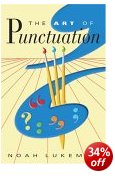how to use common marks of punctuation
Noah Lukeman is a writers’ agent with a lot of top class clients, so maybe he knows whereof he speaks on this issue. He is concerned with the business of clarifying your writing by using punctuation in an efficient manner. The unique selling point in The Art of Punctuation is that there are no grammar lessons and no attempt to bore the reader with rules and conventions. Instead, he seeks to inform by showing examples of successful use by well-known authors.
 And his exposition is aimed at creative writers, who I suspect will enjoy this approach. Most of his argument is posed in the form of metaphors (commas: the speed bumps of punctuation) and when he analyses examples, he tries to show how professional writers achieve their special effects. He starts off with an examination of what he rightly identifies as the ultimate basic set, which he calls ‘the triumvirate’ – the comma, semicolon, and the full stop. It’s amazing how much there is to say about them.
And his exposition is aimed at creative writers, who I suspect will enjoy this approach. Most of his argument is posed in the form of metaphors (commas: the speed bumps of punctuation) and when he analyses examples, he tries to show how professional writers achieve their special effects. He starts off with an examination of what he rightly identifies as the ultimate basic set, which he calls ‘the triumvirate’ – the comma, semicolon, and the full stop. It’s amazing how much there is to say about them.
You might disagree with some of his arguments. I don’t think it’s a good idea to discuss the dash and brackets at the same time, as if they perform the same function, But on the whole readers unsure about punctuation are likely to profit from what he has to say.
He illustrates his guidance with brief quotes from famous writers – all of which I think will make readers more sensitive to the subtleties of punctuation.
No iron can stab the heart with such force as a full stop put just at the right place. — Isaac Babel
I have been told that the dying words of one famous 20th century writer were ‘I should have used fewer semicolons’. — Lynn Truss
By its very form (;) the semicolon betrays its dual nature; it is both period and comma. — Eric Partridge
He’s quite good on quotation marks, and I think anyone writing character-based work would do well to look closely at the variety of different ways dialogue can be presented in prose fiction.
The same is true of the paragraph. This in my experience is a much neglected aspect of giving structure to writing. I spend a lot of time teaching my students how to identify a topic, how to introduce it, discuss it, and conclude in such a way that brings the topic to a close yet leads on to the next.
This is a non-technical and non-judgemental approach to the subject of how to give pace, flow, and cadence to your writing. It’s also full of insider tips which he drops in from time to time. For instance, he reveals that publishers’ readers will know on the first page of your submitted work if its punctuation is amateurish or professional. And they will know by page five if it goes in the bin or not. So be warned. Get it right.
© Roy Johnson 2007
Noah Lukeman, The Art of Punctuation, Oxford: Oxford University Press, 2007, pp.208, ISBN 0199210780
More on writing skills
More on language
More on grammar